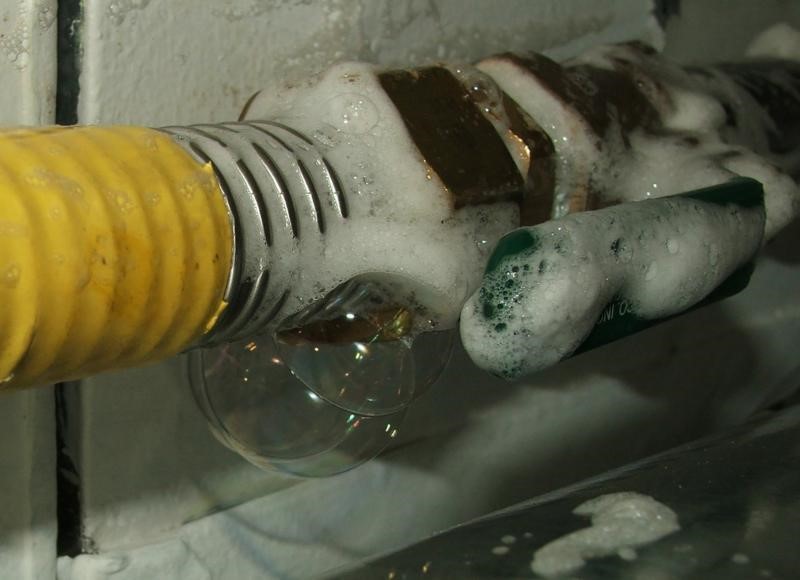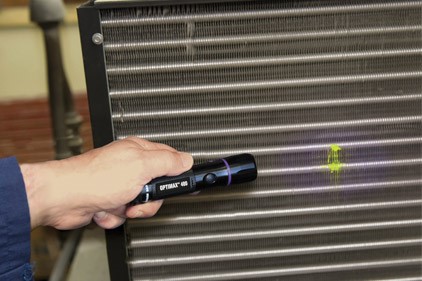How To Find Ac Leak In Home
Finding a Leak In Your AC Organisation
If you have a system that has been diagnosed with a refrigerant leak (also referred to every bit a freon leak) it may exist tempting to re-charge the unit, thank your HVAC technician and send him on his way. Unfortunately, without a proper leak check you are guaranteeing yourself a future return visit for the same issue. The length of time that your system volition function could vary from a couple of days to a couple of months, depending on the size of the leak. Leak checks are performed in three phases, as needed.
Phase Ane: Preliminary Leak Check 
Upon discovering a unit is low on refrigerant the first step is checking all fittings and coils on the organisation using a mix of electronic leak detection tools and a soap/bubble mixture. All fittings are checked for proper seating & placement and are tightened/re-sealed if needed. This typically takes 2-4 hours depending on the system. The all-time-instance scenario is that the leak is located at a fitting that can be tightened to stop it. The unit of measurement is so recharged and the piece of work is complete.
It should be noted that if a unit is found to be low on refrigerant during choppy weather (heavy winds, rain, etc.), the leak check volition need to exist re-scheduled every bit this type of weather throws off leak detection instruments and reduces visibility to meet pocket-size signs of leaks.
Phase Two: Leak Sealant / Dye

If no leaks are located during the preliminary leak check of the fittings and coils your technician has ii options for the next footstep. The technician tin begin stage 2 or skip this pace and go directly to phase 3. If the system appears to take a pocket-size/slow leak he or she tin attempt to seal the leak with a Refrigerant Leak Sealant. The sealant is colored dark-green and then if the leak is pocket-sized enough it volition seal but if it is likewise large and requires farther troubleshooting there should be traces of the dye present at the source of the leak.
This type of sealant is still fairly new and has not yet been perfected, so it should be noted that the sealant could get out backside no trace, even if it leaks out of the arrangement. If this occurs and the leak is however nowadays but not nevertheless located, your technician should move on to Stage Iii. Phase Two besides but works on systems up v tons, for larger units your technician shoul d move from Stage One to Phase Three.
Phase 3: Pressurization, Evacuation
The third stage of leak checking is the most comprehensive of the phases. If a leak cannot be located with a preliminary cheque or sealed with a leak sealant, the next step is to remove (or "recover") all the refrigerant and charge the system with nitrogen to do a comprehensive leak and pressure test. With nitrogen and trace amounts of refrigerant in the system a leak should be able to be pinpointed by going through it again with a leak detector and soap bubbles. If a leak is found and repaired, the system will be evacuated, re-charged and started back up. The existing refrigerant that was evacuated will be tested to come across if it can be reused or if fresh refrigerant is needed. Certain refrigerants require a "virgin" recharge, in which case new refrigerant will always exist used. Phase iii typically requires v-8 hours, + the cost of refrigerant and nitrogen. This timeframe will vary based on the blazon and size of equipment.
The worst-example scenario in a leak check is that information technology is located in 1 of the coils (either evaporator or condenser curl). If this occurs, your technician can determine if the coil is repairable or not. Unfortunately, coils are sometimes not possible to repair depending on where the leak is. If the leak is in a non-repairable spot, the resolution will crave coil replacement, or a total system replacement.
If you lot have whatever questions regarding the best approach for your organization, please call our team at 781-365-0222. A qualified member of our team will be happy to further discuss.
Source: https://www.controlairsystems.com/finding-a-leak-in-your-ac-system/
Posted by: coatesperis1986.blogspot.com


0 Response to "How To Find Ac Leak In Home"
Post a Comment